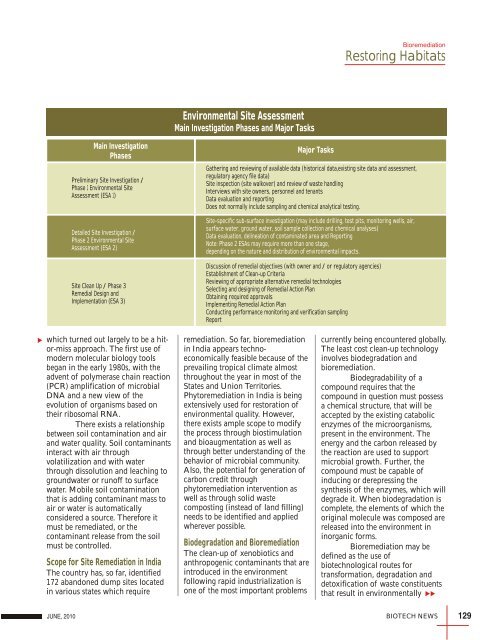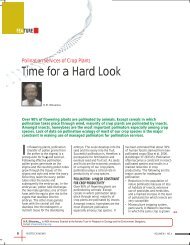Download - Biotech News
Download - Biotech News
Download - Biotech News
Create successful ePaper yourself
Turn your PDF publications into a flip-book with our unique Google optimized e-Paper software.
which turned out largely to be a hitor-miss<br />
approach. The first use of<br />
modern molecular biology tools<br />
began in the early 1980s, with the<br />
advent of polymerase chain reaction<br />
(PCR) amplification of microbial<br />
DNA and a new view of the<br />
evolution of organisms based on<br />
their ribosomal RNA.<br />
There exists a relationship<br />
between soil contamination and air<br />
and water quality. Soil contaminants<br />
interact with air through<br />
volatilization and with water<br />
through dissolution and leaching to<br />
groundwater or runoff to surface<br />
water. Mobile soil contamination<br />
that is adding contaminant mass to<br />
air or water is automatically<br />
considered a source. Therefore it<br />
must be remediated, or the<br />
contaminant release from the soil<br />
must be controlled.<br />
Scope for Site Remediation in India<br />
The country has, so far, identified<br />
172 abandoned dump sites located<br />
in various states which require<br />
JUNE, 2010<br />
Main Investigation<br />
Phases<br />
Preliminary Site Investigation /<br />
Phase 1 Environmental Site<br />
Assessment (ESA 1)<br />
Detailed Site Investigation /<br />
Phase 2 Environmental Site<br />
Assessment (ESA 2)<br />
Site Clean Up / Phase 3<br />
Remedial Design and<br />
Implementation (ESA 3)<br />
Environmental Site Assessment<br />
Main Investigation Phases and Major Tasks<br />
remediation. So far, bioremediation<br />
in India appears technoeconomically<br />
feasible because of the<br />
prevailing tropical climate almost<br />
throughout the year in most of the<br />
States and Union Territories.<br />
Phytoremediation in India is being<br />
extensively used for restoration of<br />
environmental quality. However,<br />
there exists ample scope to modify<br />
the process through biostimulation<br />
and bioaugmentation as well as<br />
through better understanding of the<br />
behavior of microbial community.<br />
Also, the potential for generation of<br />
carbon credit through<br />
phytoremediation intervention as<br />
well as through solid waste<br />
composting (instead of land filling)<br />
needs to be identified and applied<br />
wherever possible.<br />
Biodegradation and Bioremediation<br />
The clean-up of xenobiotics and<br />
anthropogenic contaminants that are<br />
introduced in the environment<br />
following rapid industrialization is<br />
one of the most important problems<br />
Major Tasks<br />
Gathering and reviewing of available data (historical data,existing site data and assessment,<br />
regulatory agency file data)<br />
Site inspection (site walkover) and review of waste handling<br />
Interviews with site owners, personnel and tenants<br />
Data evaluation and reporting<br />
Does not normally include sampling and chemical analytical testing.<br />
Site-specific sub-surface investigation (may include drilling, test pits, monitoring wells, air,<br />
surface water, ground water, soil sample collection and chemical analyses)<br />
Data evaluation, delineation of contaminated area and Reporting<br />
Note: Phase 2 ESAs may require more than one stage,<br />
depending on the nature and distribution of environmental impacts.<br />
Discussion of remedial objectives (with owner and / or regulatory agencies)<br />
Establishment of Clean-up Criteria<br />
Reviewing of appropriate alternative remedial technologies<br />
Selecting and designing of Remedial Action Plan<br />
Obtaining required approvals<br />
Implementing Remedial Action Plan<br />
Conducting performance monitoring and verification sampling<br />
Report<br />
Bioremediation<br />
Restoring Habitats<br />
currently being encountered globally.<br />
The least cost clean-up technology<br />
involves biodegradation and<br />
bioremediation.<br />
Biodegradability of a<br />
compound requires that the<br />
compound in question must possess<br />
a chemical structure, that will be<br />
accepted by the existing catabolic<br />
enzymes of the microorganisms,<br />
present in the environment. The<br />
energy and the carbon released by<br />
the reaction are used to support<br />
microbial growth. Further, the<br />
compound must be capable of<br />
inducing or derepressing the<br />
synthesis of the enzymes, which will<br />
degrade it. When biodegradation is<br />
complete, the elements of which the<br />
original molecule was composed are<br />
released into the environment in<br />
inorganic forms.<br />
Bioremediation may be<br />
defined as the use of<br />
biotechnological routes for<br />
transformation, degradation and<br />
detoxification of waste constituents<br />
that result in environmentally<br />
<br />
BIOTECH NEWS<br />
129















